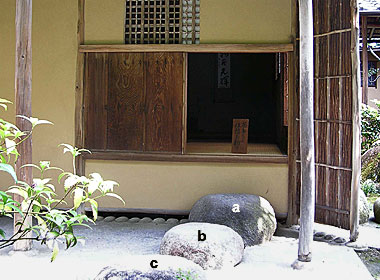|
||
 |
||

@
(C)2001 Japanese Architecture and Art Net Users System.@No reproduction or republication without written permission.
fÚÌeLXgEÊ^ECXgÈÇASÄÌRec̳f¡»E]ÚðֶܷB
|
||||||
| @ | ||||||
| fumi-ishi@¥Î | ||||||
| KEY WORD :@architecture / tea houses | ||||||
| @ | ||||||
| Lit. stepping stone. The stone placed directly under the crawl door entrance *nijiriguchi çWû, of a tea ceremony hut *chashitsu º. One of the trump stones *yaku-ishi ðÎ, because of its placement closest to the chashitsu, it is also called the first stone *hatsu-no-ishi ÌÎ. It is considered best to arrange the fumi-ishi so that the guest kneeling on it will be close to the floor of the nijiriguchi, to facilitate easy entrance. Therefore, a somewhat large stone with a flat top is used, and it is placed about 18cm away from the chashitsu so that the top is about 36cm below the entrance sill. The height of the fumi-ishi depends on the height if the nijiriguchi. Next to the fumi-ishi are the falling stone *ochi-ishi Î, and the mounting stone *nori-ishi æÎ. Occasionally, the term fumi-ishi refers to two of the trump stones located in the ornamental toilet *sunasetchin »áB. According to *CHADOU SENTEI ¹â£û (1816), the stone at the entrance to the sunasetchin is called the under-the-door stone, toshita-no-ishi ˺ÌÎ, while the stones to either side are called fumi-ishi. They are divided into the front stone *mae-ishi OÎ, and the foot rest stone, ashikake-ishi «|Î. | ||||||
| @ | ||||||
 |
||||||
@ |
||||||
| REFERENCES: | ||||||
| *koshikake machiai |Ò, *dan i | ||||||
| EXTERNAL LINKS: | ||||||
| @@ | ||||||
| NOTES: | ||||||
| @ | ||||||
(C)2001 Japanese Architecture and Art Net Users System.@No reproduction or republication without written permission. fÚÌeLXgEÊ^ECXgÈÇASÄÌRec̳f¡»E]ÚðֶܷB |
||||||
| @ |